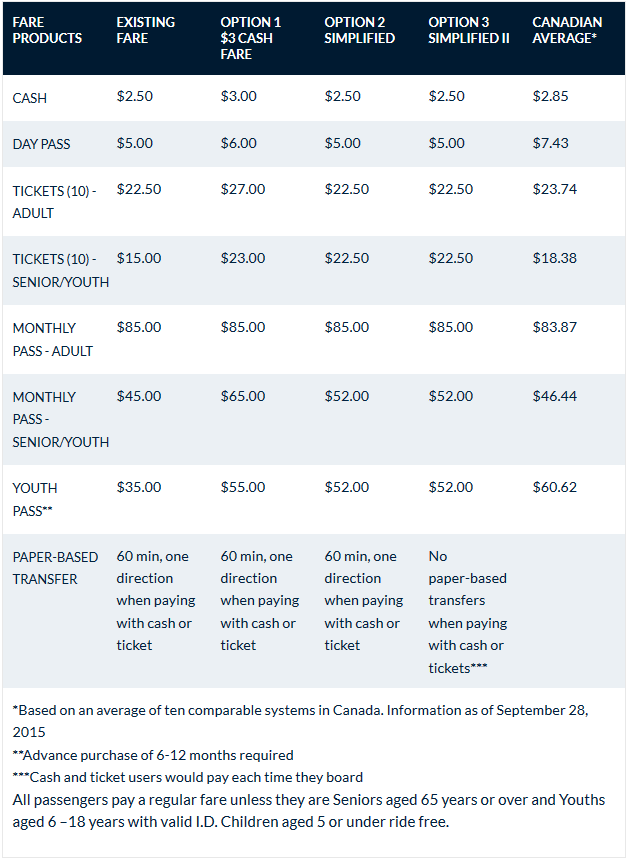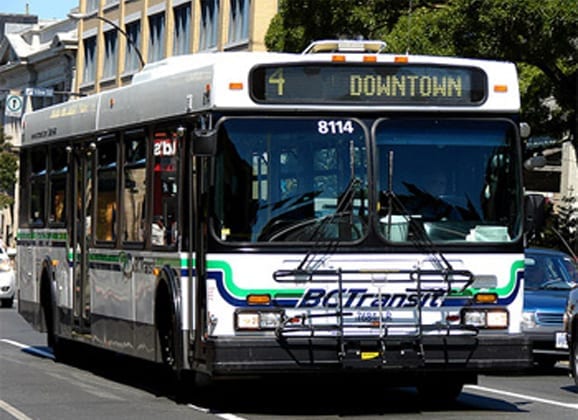B.C. Transit says it is reviewing its “fare strategy”to better balance rider revenues with operation costs and is seeking public feedback. There are several options on the table including raising fares 20 per cent to $3 per rider.
BC Transit has prepared three fare options for your consideration. All fare options assume one fare change is made at the start of the three-year period, beginning April 1, 2016.
Option 1: $3 Cash Fare – This option seeks to maximize transit user contributions and retain the current fare structure. Includes increases to the cash fare, day pass and tickets. There would be no change to adult monthly passes and paper transfers. Senior/youth pass and multi-month youth pass fares would increase.
Option 2: Simplified – Following the move to a single cash and single day pass fare in 2013, this option proposes a single ticket fare through elimination of the discount ticket, making the fare structure more user-friendly and further reducing the risk of age-based disputes. There are no changes to the cash fare, day pass, adult monthly passes and paper transfers. Senior/youth pass and multi-month youth pass fares would increase.
Option 3: Simplified II – Similar to Option 2, this option also proposes a single ticket fare through elimination of the discount ticket. There are no changes to the cash fare, day pass and adult monthly passes. Senior/youth pass and multi-month youth pass fares would increase. This option further seeks to reduce potential transit operator conflict by removing paper transfers.
 In a statement, Mike Russell, the Media and Public Relations Advisor BC Transit says fare structure reviews are done every three years in the Victoria Regional Transit System and during this review period, the Commission conducts an online survey and hosts an open house.
In a statement, Mike Russell, the Media and Public Relations Advisor BC Transit says fare structure reviews are done every three years in the Victoria Regional Transit System and during this review period, the Commission conducts an online survey and hosts an open house.
The Victoria Regional Transit System is funded through revenue from fares, local property taxes, grants from the Provincial Government, and fuel taxes.
Fares cover 27 per cent of the $32.4-million cost of running Greater Victoria’s transit system, which provides 25 million rides a year, Russell tells Times Colonist.
Only two per cent of trips — about 2,000 of the 100,000 each weekday — involve transfers, but the pieces of paper “are the No. 1 cause of conflict,” said Russell, citing disagreements over expired transfers or the use of a one-way transfer for a round trip.
“There is a lot of infrastructure needed to properly handle and account for cash [at the farebox],” Russell said. Pre-paid products streamline that process, he said, and save the system money.
The public can fill out the online survey throughout October and early November. Feedback can also be submitted by phone, email or by writing the Victoria Regional Transit Commission.
The survey, which can be found here, includes three fare structure options, approved by the Commission for review, as well as a number of questions that will help refine the new fare structure based on the feedback received from the public. The survey, and review of background information, is expected to take between five to 15 minutes.
The Victoria Regional Transit Commission will meet in December to review survey results and decide on an option. Changes will go into effect in April.






